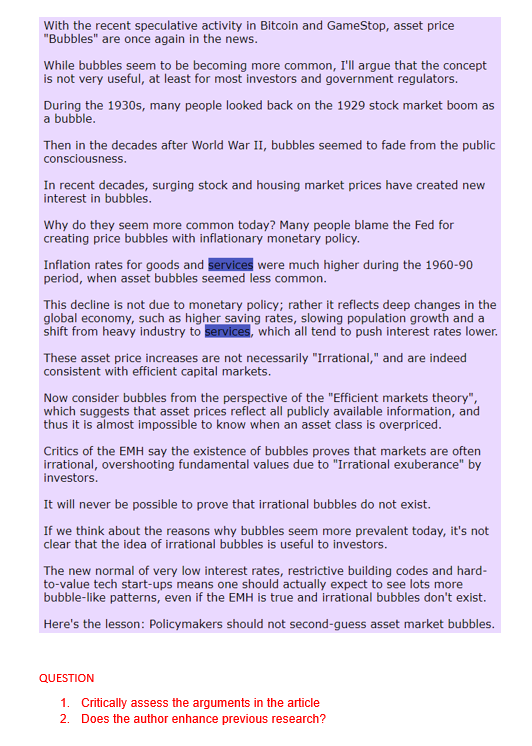
"Bubbles" are once again in the news. While bubbles seem to be becoming more common, I'll argue that the concept is not very useful, at least for most investors and government regulators. During the 1930s, many people looked back on the 1929 stock market boom as a bubble. Then in the decades after World War II, bubbles seemed to fade from the public consciousness. In recent decades, surging stock and housing market prices have created new interest in bubbles. Why do they seem more common today? Many people blame the Fed for creating price bubbles with inflationary monetary policy. Inflation rates for goods and services were much higher during the 1960-90 period, when asset bubbles seemed less common. This decline is not due to monetary policy; rather it reflects deep changes in the global economy, such as higher saving rates, slowing population growth and a shift from heavy industry to services, which all tend to push interest rates lower. These asset price increases are not necessarily "Irrational," and are indeed consistent with efficient capital markets. Now consider bubbles from the perspective of the "Efficient markets theory", which suggests that asset prices reflect all publicly available information, and thus it is almost impossible to know when an asset class is overpriced. Critics of the EMH say the existence of bubbles proves that markets are often irrational, overshooting fundamental values due to "Irrational exuberance" by investors. It will never be possible to prove that irrational bubbles do not exist. If we think about the reasons why bubbles seem more prevalent today, it's not clear that the idea of irrational bubbles is useful to investors. The new normal of very low interest rates, restrictive building codes and hardto-value tech start-ups means one should actually expect to see lots more bubble-like patterns, even if the EMH is true and irrational bubbles don't exist. Here's the lesson: Policymakers should not second-guess asset market bubbles. QUESTION 1. Critically assess the arguments in the article 2. Does the author enhance previous research? "Bubbles" are once again in the news. While bubbles seem to be becoming more common, I'll argue that the concept is not very useful, at least for most investors and government regulators. During the 1930s, many people looked back on the 1929 stock market boom as a bubble. Then in the decades after World War II, bubbles seemed to fade from the public consciousness. In recent decades, surging stock and housing market prices have created new interest in bubbles. Why do they seem more common today? Many people blame the Fed for creating price bubbles with inflationary monetary policy. Inflation rates for goods and services were much higher during the 1960-90 period, when asset bubbles seemed less common. This decline is not due to monetary policy; rather it reflects deep changes in the global economy, such as higher saving rates, slowing population growth and a shift from heavy industry to services, which all tend to push interest rates lower. These asset price increases are not necessarily "Irrational," and are indeed consistent with efficient capital markets. Now consider bubbles from the perspective of the "Efficient markets theory", which suggests that asset prices reflect all publicly available information, and thus it is almost impossible to know when an asset class is overpriced. Critics of the EMH say the existence of bubbles proves that markets are often irrational, overshooting fundamental values due to "Irrational exuberance" by investors. It will never be possible to prove that irrational bubbles do not exist. If we think about the reasons why bubbles seem more prevalent today, it's not clear that the idea of irrational bubbles is useful to investors. The new normal of very low interest rates, restrictive building codes and hardto-value tech start-ups means one should actually expect to see lots more bubble-like patterns, even if the EMH is true and irrational bubbles don't exist. Here's the lesson: Policymakers should not second-guess asset market bubbles. QUESTION 1. Critically assess the arguments in the article 2. Does the author enhance previous research







